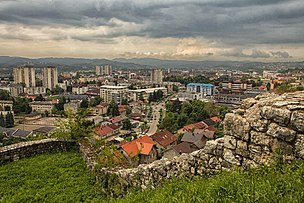Doboj
[2] It is one of the oldest cities in Bosnia and Herzegovina and, aside from Banja Luka, the most important urban center in northern Republika Srpska.
Fragments of pottery and decorative art were found on several localities, with the most known site in Makljenovac, south from the city proper, at the confluence of the Usora and Bosna rivers.
Daesitates and Breuci started the Great Illyrian Revolt, or in Roman sources, the widespread rebellion known as Bellum Batonianum (6–9 AD).
After the bloody rebellion was subdued, Roman legions permanently settled in the area and built a large military camp (Castrum) and a civilian settlement (Canabea) in Makljenovac.
The military camp was large, in the shape of a near perfect rectangle with large towers at each corner and the main gate in the middle of the central wall, and served as the most important defense on the old Roman road from Brod to Sarajevo, demarcating the very borders of the Roman provinces of Dalmatia and Pannonia.
Canabea contained Roman settlers, with evidence of a large bathhouse with a hypocaust (central heating) and a concubine house for soldiers stationed at the nearby Castrum.
Very fine pieces of religious and practical artefacts were found at these sites, including an altar dedicated to Jupiter, figurines of Mars, and fragments of African made Terra sigillata pottery.
When South Slavic tribes migrated into this area in the sixth and seventh century AD, they had settled initially on the ruins of the previous Roman settlement and lived there continuously until the early thirteenth century at which point they used stones and building material from the old Roman Castrum in order to build the stone foundation of the Gradina fortress, several kilometers north, in the modern-day old town of Doboj.
The first official mention of the city itself is from 1415, in a charter issued by Dubrovnik to the Holy Roman Emperor Sigismund, although there are numerous artefacts and objects that have been found (kept in the National Museum of Bosnia and Herzegovina in Sarajevo and the Regional Museum in Doboj), which confirm that the area had been inhabited ever since the early Stone Age, and that the Roman Empire had an army camp (Castrum) and a settlement (Canabea) in the vicinity of the town dating from the first century AD.
As an important border fortress between the Bosnian Kingdom and Hungary it was also frequently attacked, officially recorded as 18 times, in the Austro-Ottoman Wars, and fell to the Austro-Hungarians in 1878.
From their initial uprising in August 1941 up until the end of the war, the Ozren partisan squad carried out numerous diversions against the occupation forces, among the first successful operations in Bosnia and Herzegovina.
The Waffen SS "Handschar" division was partly mobilized from the local Muslim population and participated in battles around Doboj in the summer and fall of 1944.
During this time, the Ustaše fascist regime, a puppet state of Nazi Germany, purged primarily ethnic Serbs, Jews and Roma, as well as pro-Partisan civilians to concentration and labor camps.
Doboj with its surrounding area, the Ozren and Trebava mountains, was also a particularly important site for the local Chetnik armed forces.
A number of mass executions took place in Spreča Prison, on the banks of the river Bosna and in the "July 4th" military barrack in the village of Miljkovac, all in 1992.
Many of the non-Serbs were detained at various locations in the town, subjected to inhumane conditions, including regular beatings, torture and forced labour.
The man who oversaw the women's detention in the school was Nikola Jorgić, a former police officer in Doboj, who had been convicted of genocide in Germany but died during the serving of his life sentence.
[15] On 26 May 2014, it was announced that the floods and landslides had uncovered mass graves with the skeletal remains of Bosniak victims of the Bosnian War of the 1990s.
[19] The following table gives a preview of total number of registered people employed in professional fields per their core activity (as of 2018):[20] The city is the region's primary railroad junction, going south to Ploče on the Adriatic Sea, west to Banja Luka and Zagreb, north to Vinkovci, Croatia, and east to Tuzla, Bijeljina and Zvornik.
The prestige of this EHF-listed tournament was consistently strong enough to attract the most important names in the European team handball over the past five decades such as: Barcelona, Grasshopper, Gummersbach, Ademar León, CSKA, Steaua, Dinamo București, Atlético Madrid, Red Star, Metaloplastika, Partizan, Pelister, Nordhorn, Pick Szeged, Veszprém, Göppingen, Montpellier, d'Ivry and Chekhovski Medvedi.
Doboj is twinned with:[21] Una-Sana Central Bosnia Posavina Herzegovina-Neretva Tuzla West Herzegovina Zenica-Doboj Sarajevo Bosnian Podrinje Canton 10





